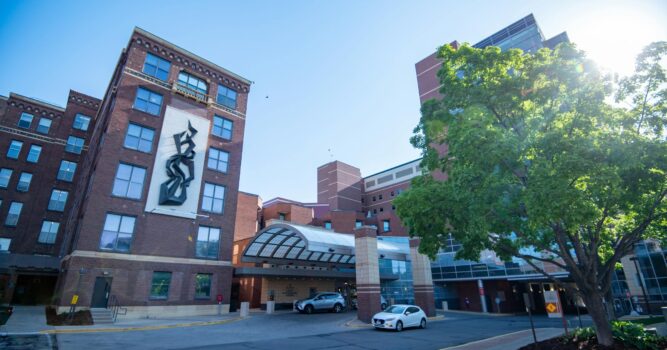A magnetic remedy for persistent despair is in such demand within the Twin Cities that Allina Well being has doubled its capability with the opening of a brand new psychological well being heart in Fridley.
Whereas antidepressant medicines and speak remedy are nonetheless the primary choices, Allina psychiatrist Dr. Bennett Poss mentioned alternate options are wanted for the rising share of sufferers who aren’t helped by these therapies alone. Transcranial magnetic stimulation has been an possibility within the U.S. for 15 years, nevertheless it emerged within the post-pandemic period as extra folks sought despair remedy and extra analysis validated its potential.
“Proof-wise, it is a kind of issues that has truly panned out higher or no less than as marketed,” mentioned Poss, who gives TMS at Allina’s Abbott Northwestern Hospital in Minneapolis. “There are such a lot of issues that look good in scientific trials after which they make it to affected person care they usually’re not so good.”
TMS entails magnetic coils which might be positioned on the scalp for round half-hour and direct pulses into the mind, normally at a golf-ball-sized goal on the entrance left aspect that regulates temper. After one to 2 months of five-day-a-week therapies, about half of sufferers report some profit and a 3rd see remission of depressive signs, studies have proven.
Poss likened it to lifting weights or operating, and he mentioned that it stimulates part of the mind that’s underutilized in folks with despair.
“We put it into use greater than you’ll in any other case, and over time it causes a number of the similar modifications you’ll truly see with train” to the physique, he mentioned.
Greater than 23% of Minnesota adults reported in 2022 that they’d despair in some unspecified time in the future, a rise from 15% in 2011, in accordance with survey data from the Facilities for Illness Management and Prevention. Minnesota in that timespan went from beneath the nationwide common to at or barely above it.
TMS is just beneficial for a fraction of these sufferers who’ve been identified with main depressive dysfunction, which is marked by extreme and extended disappointment and hopelessness. However clinicians mentioned that’s being identified extra as properly.
“The cool factor about (TMS) is as soon as folks have obtained the remedy, and in the event that they reply to it, they do not must proceed it, essentially. So it is distinct in some methods from remedy,” mentioned Dr. Sophia Albott, who heads the College of Minnesota’s division of grownup psychological well being.
The remedy has roots on the U, the place Dr. Ziad Nahas was concerned in scientific trials that persuaded the U.S. Meals and Drug Administration to approve it in 2008 as a remedy for main despair in adults.
Albott mentioned the ‘ was initially restricted to sufferers who had tried remedy and had no success, or had extreme uncomfortable side effects, with no less than 4 antidepressant medicine. The federal Medicare program just lately expanded its protection in order that sufferers solely needed to attempt two medicine earlier than being eligible for TMS, which partly explains the current progress in Minnesota.
Protection in Minnesota varies by insurance coverage plan and employer. HealthPartners typically makes use of prior authorization in its plans to verify sufferers have tried different therapies first, however Medica doesn’t use that restriction.
Albott mentioned she hopes it turns into extra of a first-line remedy, although its time dedication will stay a barrier together with the roughly $10,000 price shared between sufferers and insurers. Latest U analysis has tried to foretell which sufferers reply finest to TMS, whether or not it considerably will increase curiosity in day by day life and reduces suicidal impulses, and whether or not it may be expanded to be used by adolescents and for neurological circumstances corresponding to stroke.
The remedy already has been authorised for smoking and obsessive compulsive dysfunction, and a few researchers consider it might deal with the ear-ringing situation generally known as tinnitus, which additionally reportedly elevated in the course of the COVID-19 pandemic.
Becky Steffens, 39, of Coon Rapids, did not consider it could work, not after 15 years of coping with depressive signs. Success on the U’s clinic for treatment-resistant despair got here when her medical doctors switched sides and directed magnetic pulses into the appropriate aspect of her mind. Analysis has discovered that some sufferers want stimulation on that aspect to manage a special portion of the mind that fuels adverse ideas.
Therapy wasn’t simple as a result of it disrupted work, was noisy and uncomfortable, she mentioned. “It is like a bit of chook is pecking on the identical spot in your head again and again for like 50 minutes.”
It additionally wasn’t one-and-done success, as she wanted two rounds and once-a-week upkeep therapies together with different despair therapies. However TMS gave Steffens a number of months of full remission and lowered signs the remainder of the time that allowed her to find joys in life corresponding to portray and volunteering.
“I can have a baseline the place I am not essentially, like, comfortable and joyful and every part is nice,” she mentioned, “however I am not unhappy and caught. I really feel prefer it’s type of a spot the place I can have feelings, really feel them after which come again to a baseline … and never get caught in these adverse sticky ideas.”
Poss mentioned there shall be want for different therapies, together with extra excessive however extremely efficient electroconvulsive remedy that causes sufferers to enter seizures and “resets” their brains with out depressive signs. However he mentioned he’s notably optimistic about TMS now that it’s gaining curiosity and entry is increasing at Allina’s Mercy Hospital Campus in Fridley.





